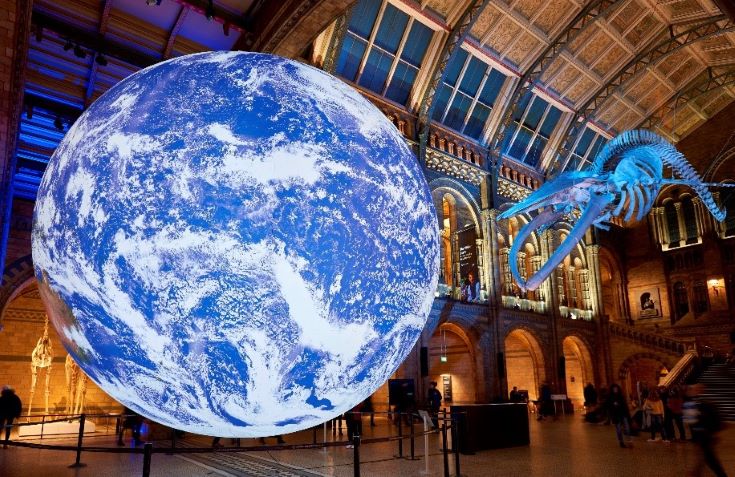The UK’s Natural History Museum declares a ‘Planetary Emergency’
The galleries at the Natural History Museum will resonate all week with sounds from nature as it declares a planetary emergency and launches a bold new strategy in response. Setting out the role it will play in tackling the planetary emergency as a global, scientific and cultural leader, the Museum describes its mission to ‘create advocates for the planet.’

Luke Jerram's Gaia artwork on display in the Museum’s Hintze Hall. Photo: copyright of the Trustees of the Natural History Museum
The strategy includes commitments to expand efforts to engage the public with planetary issues and further open up its collection to share the scientific data and evidence needed to find solutions to climate instability and biodiversity loss. Plans include:
-
the creation of new galleries and future-facing exhibition and events programme including ‘Fantastic Beasts: The Wonder of Nature’, a gallery to enable children to imagine new futures for a world where people and planet thrive, and a new world-class dinosaur gallery exploring biodiversity, extinction and climate change, featuring new specimens and exhibits;
-
leading a major new UK-wide partnership tackling urban biodiversity loss and a bold transformation of the Museum’s five-acre gardens – the Urban Nature Project;
-
launching a new year-long season of events, activities and digital content on the importance of nature and diversity – Backing Biodiversity;
-
further expanding beyond South Kensington, London by building a brand-new flagship science and digitisation centre to safeguard and share the Museum’s 80 million specimens; and
-
becoming the first museum in the world to set a science-based carbon reduction target in line with the Paris climate agreement 1.5°C global warming trajectory
The 11-year strategy opens with Sir David Attenborough’s quote: “The future of the natural world, on which we all depend, is in your hands” – a powerful reminder that it will require everyone to work together to create a sustainable future both for the planet and human civilisation. It plots the future course for the international scientific research centre and world-class tourist attraction to 2031, the 150th anniversary of its South Kensington Waterhouse building.
Director of the Natural History Museum, Sir Michael Dixon says: “We are facing a planetary emergency. Humanity’s future depends on the natural world, but we are not taking effective action to combat our destructive impact on the planet’s survival systems. Climate change, biodiversity loss and extinctions, habitat destruction, pollution and deforestation are just some of the crises which all flow from unsustainable human activity.
“In this time of unprecedented threat, we need an unprecedented global response. Our strategy is built around our vision of a future where people and planet thrive. Our ethos is one of hope that by working together we can change the current path. The Museum is well placed to make a difference, it is a world-leading science research centre and our 300 scientists represent one of the largest groups in the world working on natural diversity.
“Our ambitions include a plan to create a flagship, sustainable science and digitisation centre to safeguard a remarkable collection that explains our past, helps us chart a path for the future and provides a hub for partnerships with research institutions, museums and industry. This facility will enable us to apply brilliant minds and 21st century technologies to the Museum’s 250 years of continued natural history collecting and research and supply big critical data, supporting the global scientific effort to find solutions to the world’s ecological crisis.”
World Economic Forum meeting
The launch of the Museum’s strategy coincides with the World Economic Forum's (WEF) annual meeting in Davos-Klosters, Switzerland. For the second consecutive year, the Museum has been invited to showcase images from its prestigious Wildlife Photographer of the Year exhibition and the latest Young Wildlife Photographer of the Year, 14-year-old Cruz Erdmann, will address the Forum in a panel discussion on underwater photography and ocean conservation, joined by renowned marine biologist Dr Sylvia Earle.
In addition, the WEF is hosting three of the Museum’s world-leading experts – botanist Dr Sandy Knapp who helped establish a baseline of plant diversity in the Amazon; Head of Earth Sciences Professor Richard Herrington who is leading research into the sustainable ways to locate, extract and recycle e-critical metals; and one of the WEF Young Scientists of 2019, Adriana De Palma whose analysis of huge ecological datasets and the study of bees is helping further understanding of the impact of humans on biodiversity. The scientists will engage the world’s political, business and other leaders with the major issues facing the planet today.
For more details, visit the Natural History Museum’s website here